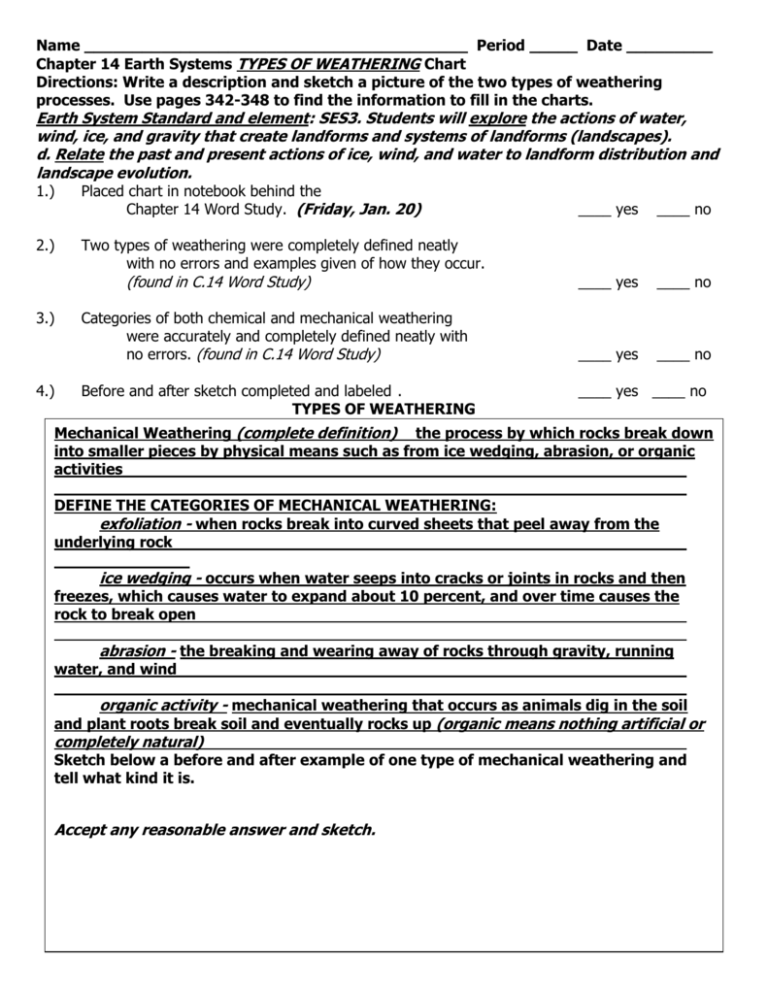Name Period _____ Date ______ Chapter 14 Earth Systems TYPES
advertisement

Name ________________________________________ Period _____ Date _________ Chapter 14 Earth Systems TYPES OF WEATHERING Chart Directions: Write a description and sketch a picture of the two types of weathering processes. Use pages 342-348 to find the information to fill in the charts. Earth System Standard and element: SES3. Students will explore the actions of water, wind, ice, and gravity that create landforms and systems of landforms (landscapes). d. Relate the past and present actions of ice, wind, and water to landform distribution and landscape evolution. 1.) Placed chart in notebook behind the Chapter 14 Word Study. (Friday, Jan. 20) 2.) Two types of weathering were completely defined neatly with no errors and examples given of how they occur. (found in C.14 Word Study) 3.) 4.) Categories of both chemical and mechanical weathering were accurately and completely defined neatly with no errors. (found in C.14 Word Study) Before and after sketch completed and labeled . TYPES OF WEATHERING ____ yes ____ no ____ yes ____ no ____ yes ____ no ____ yes ____ no Mechanical Weathering (complete definition) the process by which rocks break down into smaller pieces by physical means such as from ice wedging, abrasion, or organic activities DEFINE THE CATEGORIES OF MECHANICAL WEATHERING: exfoliation - when rocks break into curved sheets that peel away from the underlying rock ice wedging - occurs when water seeps into cracks or joints in rocks and then freezes, which causes water to expand about 10 percent, and over time causes the rock to break open abrasion - the breaking and wearing away of rocks through gravity, running water, and wind organic activity - mechanical weathering that occurs as animals dig in the soil and plant roots break soil and eventually rocks up (organic means nothing artificial or completely natural) Sketch below a before and after example of one type of mechanical weathering and tell what kind it is. Accept any reasonable answer and sketch. Chemical Weathering (complete definition) the process by which rocks break down as a result of chemical reactions such as through the processes of oxidation, hydrolysis, carbonation, organic acids, and acid precipitation DEFINE THE CATEGORIES OF CHEMICAL WEATHERING: oxidation - the process by which elements combine with oxygen and commonly occurs in rock that has iron-bearing minerals such as hematite and magnetite/the red color in Georgia Red Clay is due to iron oxides which rusts hydrolysis - a change that occurs in the composition of minerals when they react chemically with water/Example: when certain types of feldspars combine with water and form the soft, white mineral kaolin which is used in the paper industry, and to produce medications, skincare products, porcelain, and cosmetics carbonation - the process of changing minerals into a carbonate which is when specific minerals combine with carbonic acid/Examples: Limestone and chalk are both carbonates. organic acids - the process of changing minerals into a carbonate which is when specific minerals combine with carbonic acid/Examples: Limestone and chalk are both carbonates. acid precipitation - precipitation, such as rain, sleet, or snow that contains a high concentration of acids, often because of the pollution of the atmosphere Sketch below a before and after example of one type of chemical weathering and tell what kind it is. Accept any reasonable answer and sketch.








